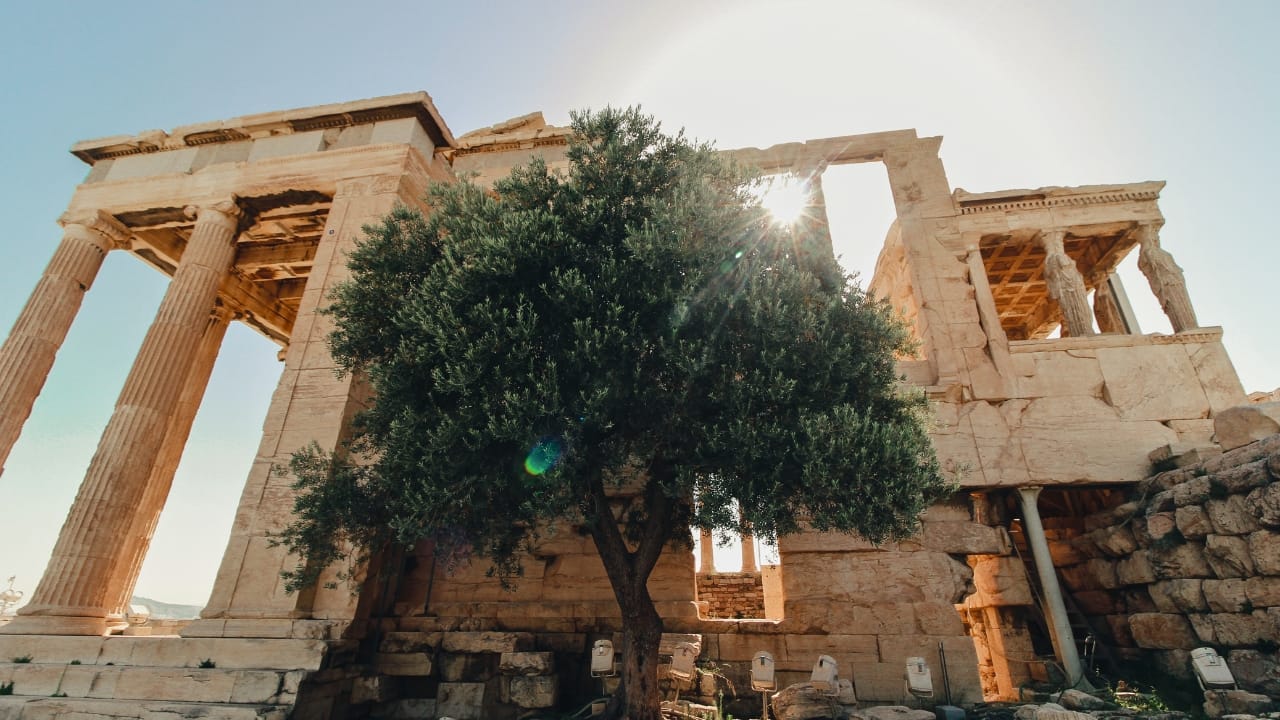Enduring Symbols: Special Living Trees around the World
Like the Banyan Tree in Lahaina, Hawaii—miraculously recovering from the devastating Maui fire of 2023—the Oak of Guernica in the Basque Country, Spain, and the Bodhi Tree in Bodh Gaya, India, the Olive Tree at the Acropolis of Athens has held immense significance for the city since the dawn of recorded history. It continues to do so today.
Contest between Athena and Poseidon
According to mythology, back deep in the mist of time, the contest between Athena [1] and Poseidon for the patronage of Athens was not a physical battle, but rather a symbolic competition of gifts, each deity offering something they believed would most benefit the city.
Poseidon, the god of the sea, stepped forward first. With a mighty strike of his trident against the rocky ground of the Acropolis—the “high city” of Athens—he created a saltwater spring, or well, known as the "Sea of Erechtheus," which surged up from the earth. This spring was a powerful symbol of Poseidon's dominion over the seas, a vital resource for a city engaged in trade and maritime activities. The Athenians recognized the strength and grandeur of Poseidon's offering. However, the water from the spring was salty and not particularly useful for drinking or agriculture.
Next, it was Athena's turn. The goddess of wisdom, military victory, crafts, and practical reason, Athena offered a different kind of gift. She gently planted an olive tree on the Acropolis a seemingly modest offering compared to Poseidon's spectacular display. Yet, this tree was no ordinary plant; it was a symbol of peace and prosperity. The olive tree promised the Athenians not only food in the form of its fruit but also oil for eating, cooking, lighting, medicine, religious rituals, etc., as well as wood for building and crafting. Additionally, olive oil was a vital commodity for trade, which would provide economic stability for the city.

The Athenians' Decision
After careful consideration, the Athenians decided that Athena’s gift was more valuable to their daily lives and future prosperity. It was offering the means to thrive in peace and to meet many of their needs. Its significance went beyond the physical; it represented wisdom, civilization, and the enduring spirit of the people.
The Name of the City

By choosing Athena’s gift of the olive tree, the people of the well-placed city near the sea—surrounded by beautiful mountains on three sides and blessed with a mild climate that fostered advancements in arts and sciences—honored her as their patron goddess and named their lovely city after her. To this day, this is how the city is known by Greek-speaking people around the world.
It’s poignant to imagine that if Athena had lost patronage, the historic city might have been named Poseidon rather than Athena, as it has been known in recorded history since at least the Mycenaean period (c. 1600–1100 BC). The name has continued in use without interruption since antiquity—a distinction that sets it apart from many other ancient Greek cities, particularly those in Asia Minor, whose names and people have changed over the centuries. And this naming is thanks to the very wise and modest gift of an olive tree. [2]
The Olive Tree and the Pandroseion
The tree stands beside the stunning Erechtheion temple, which was constructed long after the tree was planted. But even before the Erechtheion was built, there was another temple on the Acropolis, the Pandroseion. Named after Pandrosos, one of the daughters of Kekrops, a mythical king of Athens, the Pandroseion was an open-air sanctuary. It was a small, walled area that had no roof, allowing for direct contact with the natural elements, something the tree of course required. This sanctuary was a place of profound spiritual significance, and was, among other things, the keeper of the very special olive tree. When the Erechtheion was later constructed during the Golden Age of Greece, it was built around this revered site, incorporating it into its design, thus preserving its legacy.
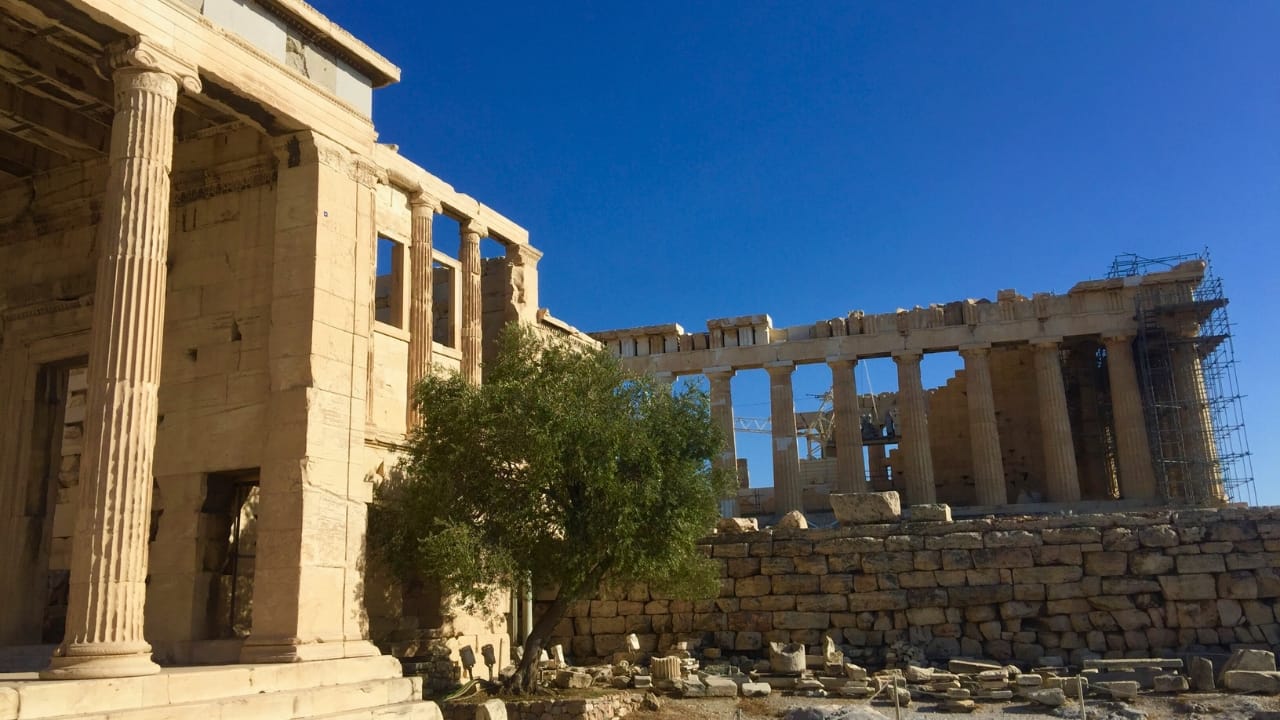
The Erechtheion
Built between 421 and 406 BC, the Erechtheion was, and still is, even in its ruinous state, a masterpiece of architectural wonder. The temple was unique in its asymmetrical design, which was meant to accommodate the irregular terrain of the Acropolis as well as the various sacred sites it enclosed, such as the above mentioned much earlier Pandroseion. Named after Erechtheus, another king of Athens, the Erechtheion was one of the most important sites on the Acropolis. Dedicated to both Athena and Poseidon, as well as to other deities such as Hephaestus, the temple honored several of the city’s most revered religious artifacts. Among these was not only the olive tree planted by Athena but also the saltwater well created by Poseidon.
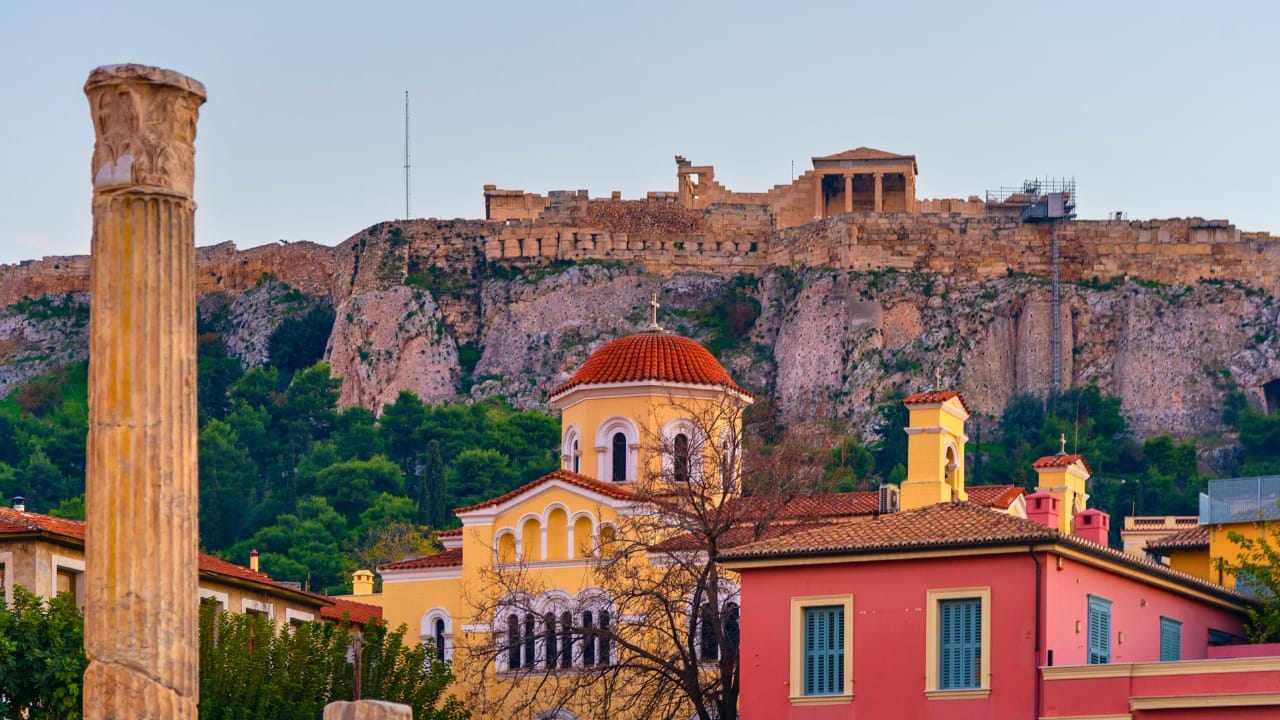
The Resilient Olive Tree: A Testament to Athens' Endurance
The current olive tree, thought to be a descendant of the one gifted by Athena, has weathered numerous near-destructions throughout its millennia-long history. Despite these challenges, it has persistently endured. Let’s explore some of these pivotal moments.
Persian Invasion — 480 BC
The first significant threat to this sacred olive tree came during the Persian invasion of 480 BC. Led by King Xerxes I, the Persian forces swept through Greece, and when they reached Athens, they set fire to the city, including the Acropolis, devastating its temples and sacred spaces. The olive tree was not spared and was burned along with most of the city. However, Herodotus in Book 8, Chapter 55 of his work, Histories, claimed "on the day after its burning, when the Athenians ordered by the king to sacrifice went up to the sacred precinct, they saw a shoot of about a cubit's length [about a meter] sprung from the stump, and they reported this." The 5th century BC Athenians, their city now in ruins, interpreted this as a powerful sign from Athena herself, a reassurance that their city would rise again, just as the tree had regenerated. And rise it did reaching the classical heights admired around the world even today.
Heruli Destruction — AD 267
In AD 267, the Heruli—an East Germanic tribe originally from Scandinavia, known for their seafaring skills, piracy, and destructive behavior—sacked Athens, which was then under Roman occupation. This raid was part of the broader wave of invasions and instability that plagued the Roman Empire in the 3rd century AD. The devastating destruction of the entire city, including the Acropolis, stands as one of the darkest events in Athens' long history. It marked a significant turning point, accelerating Athens' transition from a major classical city to a more provincial Roman town as Rome's ability to protect its territories waned. However, despite the silence of written records, the Sacred Olive Tree—or most likely a shoot from it—survived once again, symbolizing the enduring spirit of the city.
Erechtheion Transformation – Christian Church – AD 5th or 6th century
Around the 5th or 6th century AD, as Christianity became the dominant religion in the Late Roman Empire, the Erechtheion–the protector of the tree–was transformed into a Christian church. This was part of a broader trend where many ancient Greek temples, now that the Unknown God of Acts 17:23 [3] had become known to the Greek and Roman world, were repurposed for Christian worship. Olive oil holds significant importance in Christian worship and rituals, which likely contributed to the protection and reverence of olive trees, including the most famous one at the Acropolis.
The Ottoman Occupation – AD 1458 to 1833
Then, during the Ottoman period, the Erechtheion, which had thus long guarded the sacred olive tree, was converted into the residence of the Ottoman commander, including a harem. The Islamic cultural reverence for olive trees and olive oil likely contributed to the respect and protection of the Sacred Olive Tree on the Acropolis. The historical significance of the tree would have been recognized, and efforts to preserve it would have aligned with the broader Islamic respect for nature.
Venetian-Ottoman Wars – From 1463 to 1718
The Erechtheion endured further damage during the Sixth Ottoman-Venetian War. On September 26, 1687, the Venetian forces under Francesco Morosini [4] bombarded the Acropolis. While the 2,134-year-old Parthenon, largely intact until then, was devastated and became the classical ruin we see today, the Erechtheion also sustained damage from the explosions. But it is likely that the tree, somewhat protected as it was behind the western wall of the massive building, below the Porch of the Maidens—which also survived—probably survived too. At least a shoot of the tree did.
Nazi Germany Occupation WWII – April 27, 1941 to October 12, 1944
Centuries later, in what could still be considered our modern era, the olive tree faced another perilous moment. Athens was occupied by Nazi Germany, and the Acropolis, a symbol of Greek heritage, was under constant threat. Unlike the destruction caused by the Heruli more than 1,600 years earlier, the Acropolis itself was not destroyed. Although the olive tree was not directly targeted, it suffered from neglect and the ravages of war. Resources such as water, food, and medicines were scarce, and the city and its starving population endured tremendous strain. After the war, it was found that while the tree was damaged, it remained alive. Once again, it was nurtured back to health, allowing new shoots to grow and ensuring the tree’s continued presence in the city. (See our sister site, PJKabos.com, and the article "Quest for the 'Sacred' Olive Tree of the Acropolis of Athens" for more information on this remarkable tree and how olive trees can propagate and live on through their descendants.)
The tree’s survival into modern times, despite wars and occupations that transformed the Acropolis, suggests that, after the destructions by the Persians, the Heruli, and Morosini, there was no fanaticism specifically aimed at destroying the Acropolis or harming the Sacred Olive Tree gifted to Athens in time immemorial. However, any subsequent care or reverence for the tree would likely have been informal, local, or personal, rather than driven by religious or official motivations.
Today, the living, fruit-bearing olive tree, most likely a descendant of the original, continues to thrive picturesquely on the Acropolis, nestled among the uneven terrain just below the Erechtheion’s famous Porch of the Maidens.

Harmony in Leaf and Stone: The Olive Tree and the Caryatids
The Porch of the Maidens, or Caryatids, is a masterpiece of ancient Greek architecture, featuring six draped female figures that serve as elegant architectural supports for the roof. This iconic porch was likely used for religious ceremonies, with the revered Sacred Olive Tree standing nearby. While there’s no direct evidence that the architects of the Erechtheion specifically designed the porch with the olive tree in mind, the porch's proximity to the sacred site underscores its importance in the city's rituals and daily life. The Caryatids, renowned for their grace, evoke the natural beauty and harmony prized in Ancient Greece, reflecting a deep appreciation for the surrounding landscape. The sight of this majestic and historically significant olive tree swaying gently (and sometimes not so gently in the strong Athenian winds!) near the porch creates a timeless image, representing the perfect balance between nature and the refined artistry of Ancient Greek architecture and thought.
The wind was so strong on this summer day that keeping the camera steady was a challenge. Fortunately, the tree seemed unfazed by the gusts, which is a relief given how often Athens experiences strong winds.
The Olive Tree at the Acropolis: A Living Monument to Greece's Timeless Strength
The tree stands as a living monument to the city’s mythological and cultural heritage. Each time this silver-green tree has faced near destruction, it has, one way or another, regenerated—mirroring the resilience of the city and its people across ancient, medieval, and modern eras.
The Banyan Tree of Lahaina, Hawaii and the Sacred Olive Tree of the Acropolis
Today, a comparison can be made to the Banyan Tree in Lahaina, Hawaii, which suffered grievously in last year's Maui fire. Just as the Acropolis Olive Tree has repeatedly risen from its trials to inspire generations, the Banyan Tree seems to be emerging once again, filling hearts across the United States and the world with renewed hope and gladness.
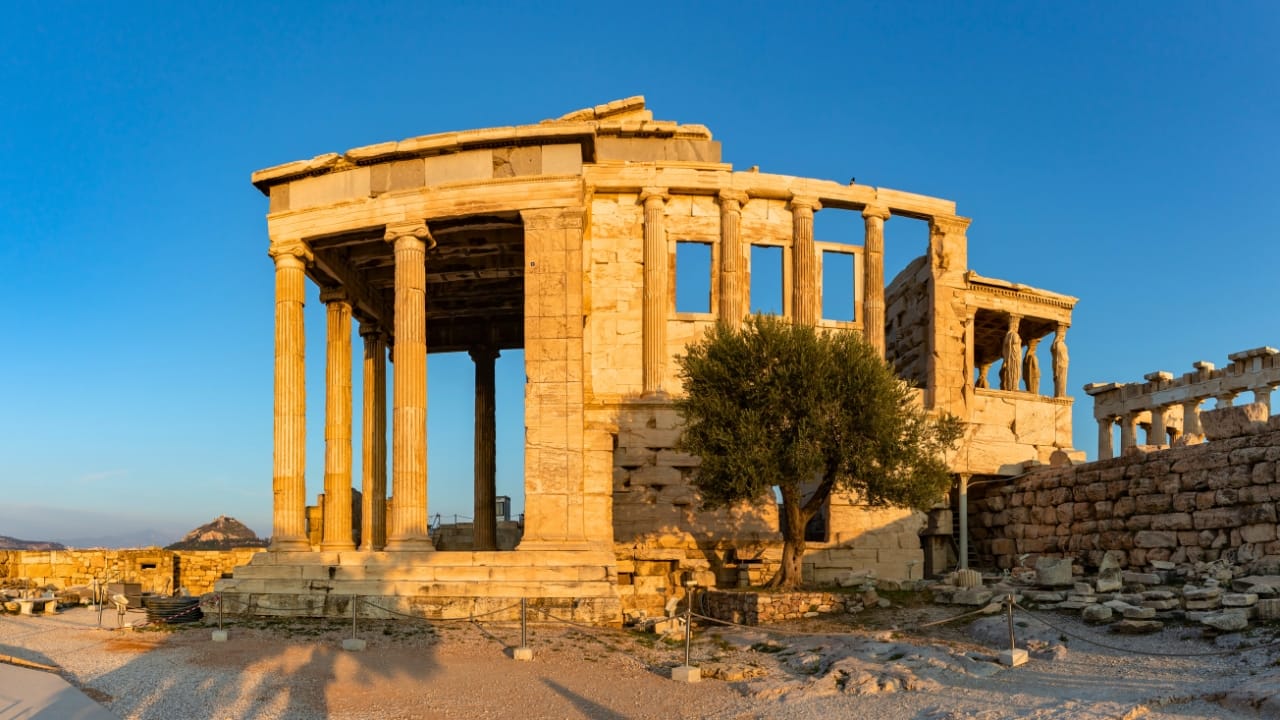
[1] Note: The name of the goddess Athena is with the accent on the final a. The name of the city of Athena is with the accent on the e. See footnote 2.
[2] The Roman historian Pliny the Elder referred to the city as "Athenae" in Latin, a term widely used throughout the Roman Empire. This Latin name was derived from the Greek "Athēnai" (Αθήναι). By the 14th century, the English-speaking world began using the term "Athens," influenced by Latin translations and classical references. During the Renaissance and early modern period, "Athens" became the standard English term for the city. However, this was not a change in the name or its nature but rather a translation as "Athenae" in Latin and "Athens" in English are both derived from the original Greek name "Athēnai."
[3] Acts 17:23 — St. Paul speaking to the Athenians "For as I passed by, and beheld your devotions, I found an altar with this inscription, To The Unknown God. Whom therefore ye ignorantly worship, him declare I unto you." KJV
[4] Morosini's Venetian campaigns were marked by strategic military actions and significant destruction of many important cultural and historical sites, ancient, Byzantine and medieval throughout Greece. Among these, the most enduring and painful for Athenians and people worldwide is the destruction of several buildings on the Acropolis of Athens, particularly the Parthenon.
Please see our sister site, pjkabos.com (under "The Fat Olive) and "Quest for the 'Sacred' Olive Tree of the Acropolis of Athens" and my first time up at the Acropolis and my search for this tree. I was so surprised to find that it was there.
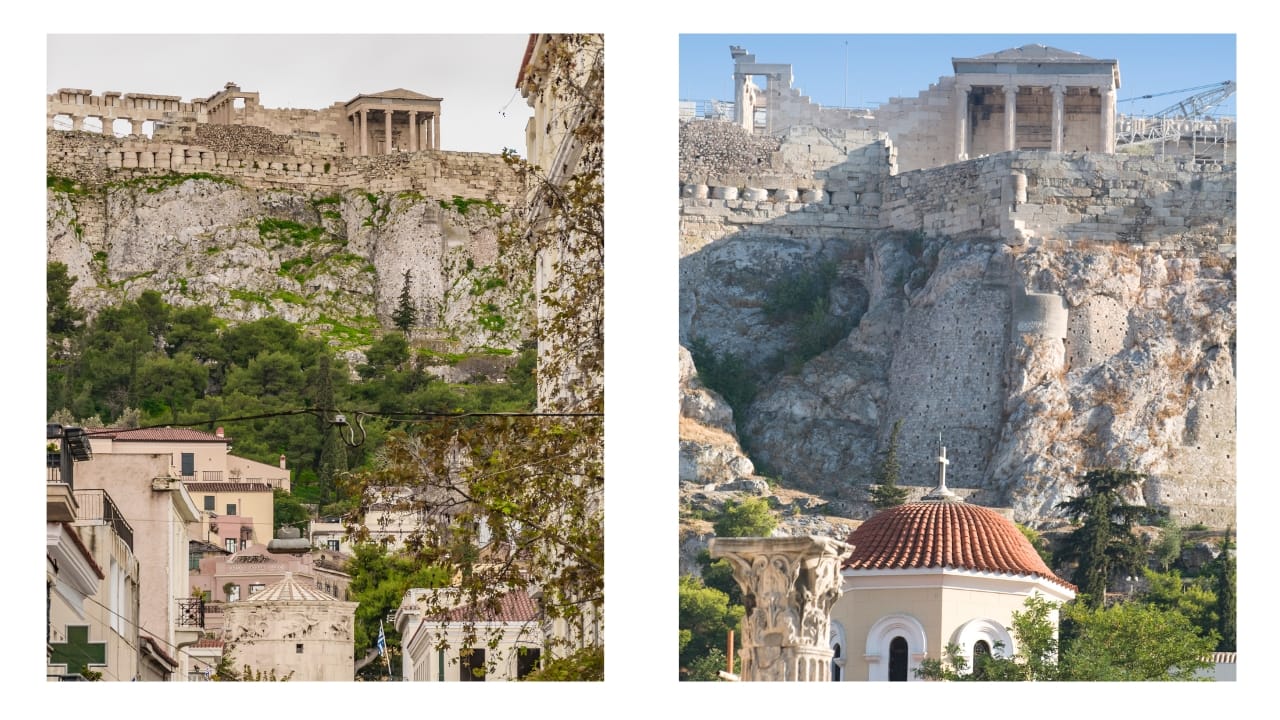
Fresh Harvest 2024/25
High-Phenolic Extra Virgin Olive Oil
from PJ KABOS
PJ Kabos Family Reserve Organic—Phenolic Shot
(Gold Bottle)

PJ Kabos Family Reserve Organic—"Phenolic Shot," is an award-winning extra virgin olive oil with possibly the highest phenolic content available in a true extra virgin olive oil today. Its intense bitterness and pungency clearly reflect the activity of these polyphenols. Meant to be taken as a shot or may be drizzled over salads, roasted vegetables, toast, fava, etc. to amplify both flavor and health benefits.
PJ Kabos Family Reserve Organic—Robust
(Black Bottle)
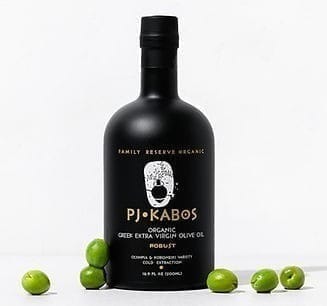
PJ KABOS Family Reserve Organic - Robust, is an extra virgin olive oil that is very high in polyphenols and adds depth, character and great health benefits to every meal.
PJ Kabos Family Reserve Organic—Medium Taste
(White Bottle)

PJ KABOS Family Reserve Organic - Medium, is an extra virgin olive oil that is high in polyphenols and adds a lovely taste and great health benefits to every meal.
PJ Kabos Family Reserve—Medium Taste
(White Tin)

PJ KABOS Family Reserve - Medium, is an extra virgin olive oil in an easy-to-store tin that is high in polyphenols and adds a lovely taste and great health benefits to every meal.
Please enjoy having a look around our websites, pjkabos.com and oliveoil.com, as well as our Amazon Store for more about our many high-phenolic olive oils, recipes, history, etc. And follow along with us on Instagram for photos concerning olive oil production, our groves in Greece, articles about olive oil, family history and more.
PJ Kabos High-Phenolic Extra Virgin Olive Oil: Your Trusted Oil, Straight from Our Table to Yours.

